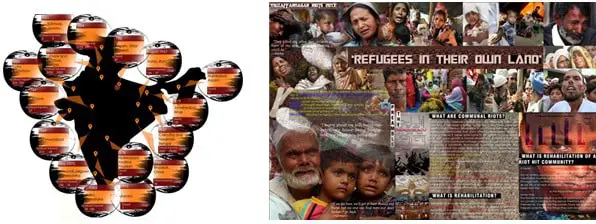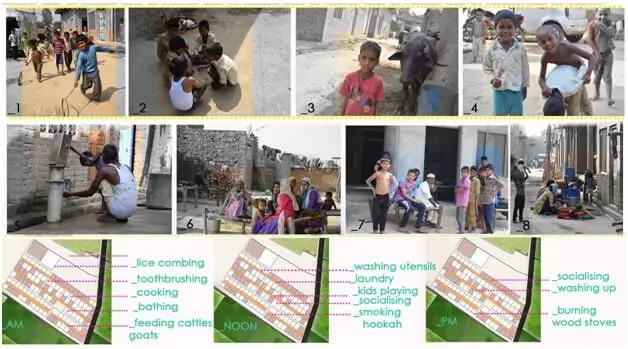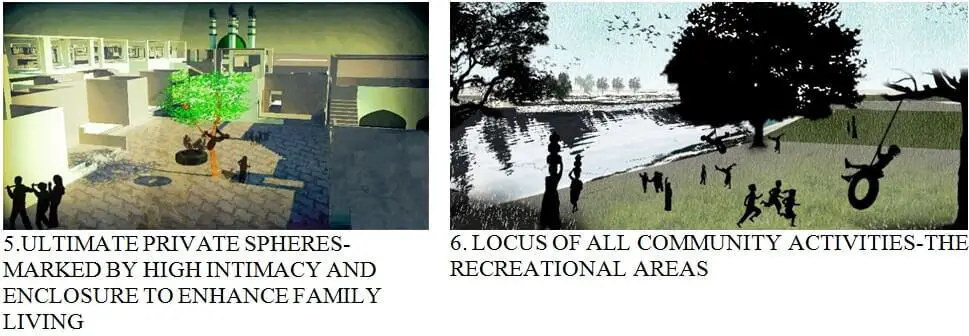Title: Losing the tag of a riot hit colony : case study of Palda village,Muzaffarnagar,UP.
Aim
The project is an attempt to amend the relationship of the riot hit community with the rest of the world and remedying their situation through various social interventions and providing infrastructure to generate self employment and fulfilling requirements of self employment recreation,education and healthcare.
Objectives:
- Building a belief that the world is a safe place,developing a sense of security and safety in the traumatized ones and at the same time maintaining public concern and interest.
- To develop it as a secure and stable neighbourhood community where all the basic needs are fulfilled.
- Promote community participation and encourage local entrepreneurship to restore economic productivity by creating a new morphology for self employment practices in such communities.
- To make a conscious effort in evolving social networking to ease their exposure ensuring that it is linked and interacts with the major nearby towns and suburbs.
Scope:
- Providing architectural solutions so that the needs of these internally displaced persons are met in terms of safety, community/belonging,esteem and self actualisation.
- rehabilitation housing for the victims
- nursing homes,dispensary
- secondary level education
- public spaces for local interaction
- Creating ownership among the community,Long term focus and developing relationships. Generating income through home based enterprises which has a multiplier effect on the society.
- local set up of cottage industries
- skill development centre,vocational training centre
Limitations:
- No concrete source available to collect data on pre riot conditions.
- Media manipulation create an image that results in ambiguity and thus it fails to ensure a piece which meticulously present both sides of the story.
- Due to certain circumstances visiting nearby riot hit villages is not possible ,hence it limits our reach.
- Site available might not accommodate all the requirements therefore land acquisition proposal has to be given.
Need for Study: Traditionally, rural settlements represent the best synthesis of people’s ability to modify the environment to their own advantage. Moreover India on the lines of an alleged developing nation is rapidly rising on the ashes of its backwoods. Nearly five lakh villages exist in India. While only about 28 per cent of the population lives in the cities, 72 per cent of the population lives in the villages. The villages thus occupy a place of great importance in the country.
Background & Findings:
The plight of the survivors of Muzaffarnagar (UP) riots are stranded between the apathy and ostracism of the society and they speak a very different story.
The present is of suffering, longing and depravity where hopes for a better future is non-existent.
Making the situation worse is the silent suffering and the life of anonymity they are forced to lead in absence of any media coverage and efforts of outreach.
The common public needs to be informed and sensitized to their existence and calls for help.A grave humanitarian crises has unfolded in Palda (Refugee village in Muzaffarnagar) and as an architect we need to seek architectural solutions to humanitarian crises and bring professional design services to communities in need.We cannot all be there by ourselves but we can make a difference. We can and will change lives. To take their pleas and to convert it into a public movement of kindness and sharing.
 1. Geography of India rendered with communal riots.
1. Geography of India rendered with communal riots.
- Humanity is dying.
All living beings on mother earth are entitled to live a secure life with familiar surrounding around them. But they were left with nothing of this when the misfortune struck. The children of the misery, never in the worst nightmare could have ever thought that this would be the last day they had the meal with their family, last day to sleep in the safety of their parent’s embrace, the last day to call a house home. Had they known they would only wish tomorrow never to come.Their needs could be endless but they could be helped with basic necessities to begin with. As Maslow(1943) stated that ‘people are motivated to achieve certain needs. One must satisfy lower level basic needs before progressing on to meet higher level growth needs. Once these needs have been reasonably satisfied, one may be able to reach the highest level called self-actualization’.[1] Unfortunately, progress is often disrupted by failure to meet lower level needs. Muzaffarnagar riots in September 2013 has prompted several villages to fight the situation of a civil unrest where provision for the restorative relief, rehabilitation and compensation to all persons affected by communal violence was very difficult due to the disconnect it faces with the state administration. It is absolutely clear that even the best efforts of the army cannot prevent killings once rural areas get affected by the communal virus. It resulted in at least 62 deaths including 42 Muslims and 20 Hindus and injured 93 and left more than 50,000 displaced. However the government has passed various bills to punish the culprits of any communal carnage but unfortunately it has failed miserably to protect victims from the aftermath of riots because it is yet to frame the rules needed to channelize the rehabilitation process.These Rehabilitation policies loopholes can be fixed to an extent with various architectural interventions and suggestive strategies can help towards bridging the gap between policy and practice of state administration.

- Timeline of Muzaffarnagar riots – an untold story
I believe through architecture we can attempt to amend the relationship of the riot hit community with the rest of the world by remedying their situation through various social interventions, provide infrastructure to generate self-employment and fulfill requirements of recreation, education and healthcare. The vision is to empower the riot hit community as here the people are most vulnerable and later structure the revival of their settlement that fulfill their needs, reach their full potential (identifying unrealised capabilities) and live with dignity and free of stigma. To provide opportunities to create a healthy neighborhood and eventually weave a fabric of community through multiple levels of participation thus creating avenues to mainstream social inclusion. Through applying principles of urban planning we can enhance the imageability of the community showing that the families are empowered, educated ,employed and strong advocates of their rights-(Kevin Lynch)[1].The current situation is fraught with possibilities , dilemmas , varying opinions, impossible altruistic goals , negligible economic leeway and vast social connotations. Therefore a scheme has to be created that resonates with the people of refugee colony ,allowing them to grow as dignified employed individuals, providing them with a habitat where they can live and work.
We need to design an interface through which they can interact with the world at large. The architecture therefore has to grow out of the needs and aspirations of people of this village and yet it has to be economically viable and replicable on a rural scale. This will create a better standard of life without infringing on the just income to be made by the refugees. A pilot programme needs to be formulated for this road to recovery. Various steps can create a ripple effect in the riot stuck ghetto such as providing architectural solutions so that the needs of these internally displaced persons are met in terms of safety,community/belonging,esteem and self-actualization (rehabilitation housing for the victims that will add a specific value to people’s assets allowing for leverage of wealth as credit collateral, nursing homes,dispensary , secondary level education as students are not issued transfer certificates from their old school and they are not given admission in any of the government school, public spaces for local interaction that will result in social equity thus bridging the dichotomy and creating empowerment for social outcast to fight the mold of social stigma. Also creating ownership among the community, long-term focus and developing relationships by generating income through home based enterprises is important. This will surely have a multiplier effect on the society. For instance coming with a local community intervalefarm, local set up of cottage industries ,skill development center ,vocational training centre will give the victims their social identity back and provide them with opportunities for self-employment and wage employment,financial assistance and social employment. This can be done by gauging the community’s partnership potential. Through this we will be able to create the patches of remembrance by reconstructing from memory and preserving the cultural identity. The idea to inject new people into the colony allowing it to shed its image and work towards a cohesive neighborhood as community life is the key component of post trauma recovery and it can provide psychological healing to these emotionally, psychologically, monetarily damaged people who are living in a ghetto.
A conscious effort has to be made in evolving social networking to ease their exposure ensuring that it is linked and interacts with the major nearby towns and suburbs. All this will build a belief that the world is a safe place, develop a sense of security and safety in the traumatized ones.
Also the street design of such areas has a major influence in transforming a ghetto into a good neighbourhood. Identify the street activities and give a scope to retain them in the new design. As rightly said by Jane Jacobs ‘there must be eyes upon the street, eyes belonging to those we might call the natural proprietors of the street’[2], we need to keep the very idea of street watching alive and realize that people do like basics – and as environments go, a street that is open to the sky and filled with people and life is a splendid place to be.

- Identifying internal street character
The neighborhood has to be designed in a way that it keeps the essence of a village alive. Small private intimate spaces between the dwelling units will build a community spirit as these victims are ambiverts. Their new enclosure should depict an all living a happy and natural life.I see happy faces greeting each other every day and a society working towards a cohesive neighborhood.

Keywords: Gender-sensitive, Sex-disaggregation of data, Women’s empowerment, Gender mainstreaming, Gender impact assessment
About the author
 I am a graduate in Architecture from F/O Architecture &Ekistics ,Jamia Millia Islamia.Currently pursuing M.Ekistics from Jamia.I work as an Assistant Field Investigator at the Slum Rehab Dept of DUSIB-Delhi Urban Shelter Improvement Board.(Govt. of NCT of Delhi).
I am a graduate in Architecture from F/O Architecture &Ekistics ,Jamia Millia Islamia.Currently pursuing M.Ekistics from Jamia.I work as an Assistant Field Investigator at the Slum Rehab Dept of DUSIB-Delhi Urban Shelter Improvement Board.(Govt. of NCT of Delhi).
More detailed work can be downloaded here.
Kindly contact at [email protected] to request more information about author/ dissertation
IMAGE COURTESY: Source of graphics used:Author
References:
[1]Kevin Lynch – The Image of the City | The Mobile City
[2]The Urban Wisdom of Jane Jacobs – Page 198
[1] https://www.indiacode.nic.in/coiweb/coifiles/preamble.htm